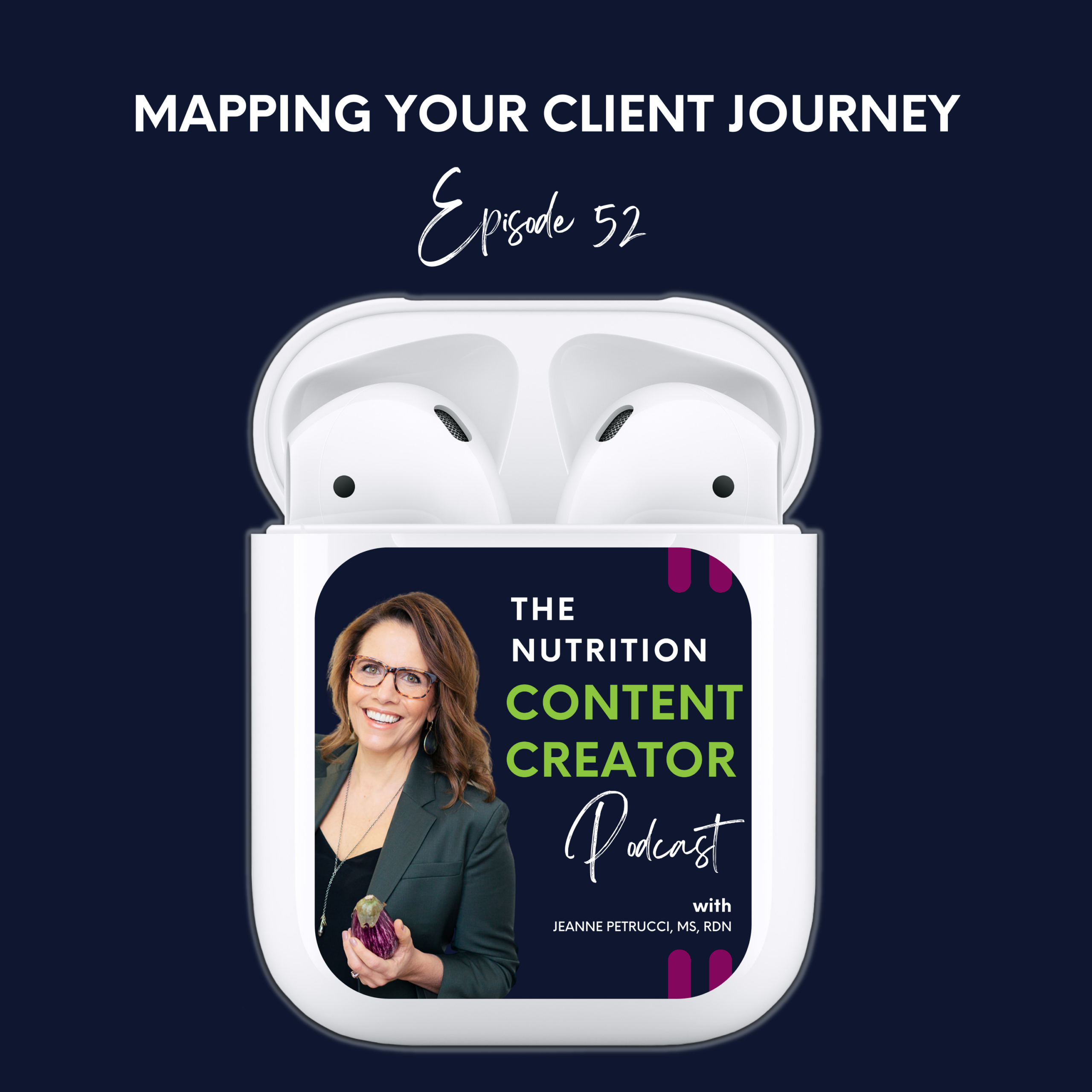23. Motivational Interviewing

My course experience in Nutrition Counseling surprised me. It was one of my final classes in my Master’s program at Teachers College, Columbia University and it was one of my favorites. After three years, I thought I was armed with everything I needed to know to begin my private practice journey – to be able to tell people what they needed to do to change their nutrition-related health behaviors and meet their health goals.
Did you hear what I said? “To be able to tell people what they needed to do…” That’s truly what I thought and I was so wrong. And it’s not just semantics.
Telling people what to do, even if they are coming in and asking specifically for that, is a HUGE mistake for so many reasons.
First, it’s an exhausting way to counsel and leads to burnout.😰
Second, it doesn’t explore the patient’s intentions, motivations, capabilities, barriers, etc. Telling a patient what to do is more about you mapping out a plan than about them participating in the process to create a sustainable path to success.
We’ll cover:
- The Spirit of MI: Collaboration, Evocation, Autonomy, and Compassion
- Four Core Principles of MI: Empathy, Autonomy, Rolling with Resistance, and Developing Discrepancy
- The O.A.R.S. Framework
Before my Nutrition Counseling course was even over, I knew I would get advanced training from the person who wrote the book [literally and figuratively] on Motivational Interviewing [MI] for nutrition professionals, Molly Kellogg. For those of you who are not familiar with Molly and her work, she is a licensed Psychotherapist, Registered Dietitian, and writer.
I remember one of the first things she said early in her program, “If you’re in your office hoping your next patient will cancel because you’re so exhausted, it’s time to learn MI.”
Motivational interviewing places the responsibility for change on the patient, where it belongs. Not on you.
It is a client-centered approach that encourages individuals to make behavior changes by helping them explore and resolve their ambivalence. Motivational Interviewing was originally used in the field of addiction therapy, but its use has expanded to various healthcare settings, including nutrition counseling. The essence of MI lies in facilitating a collaborative conversation that allows clients to articulate their reasons for change, rather than imposing your “expert” perspective onto them.
It’s hard for us, though, because we have been trained to see the path to success. To understand the science behind changes necessary to drive positive health outcomes. But for patients, simply being educated, forced, or nudged down a path of behavior change does not work. And neither does a firehose of content and resources.
Here’s an example of what the choice to use MI might look like in practice and how it can guide content selection:
Patient: I want a meal plan
Practitioner: You have two choices here.
- You can either provide them with said meal plan, thereby satisfying their immediate perceived need or
- You can explore why they are asking for one in the first place by asking a simple question to facilitate a conversation: “Why do you think you need a meal plan?”
If you prematurely issue the content – the meal plan – you risk overwhelming the client and diluting the personalized guidance they need.
Taking the time to ask the question will reveal the barriers standing in the way of your patient’s success and will provide you with the opportunity to explore content that will support, not overwhelm them.
Responses to, “Why do you think you need a meal plan?” may be:
- I don’t know what foods to eat
- I don’t have time to create a meal plan
- I’m not confident in the kitchen
- I get frustrated making recipes my family won’t eat
I’m sure you could think of a dozen or more responses you would expect to hear from your clients
These responses inform your intervention which will, no doubt, include the delivery of a variety of content – which may or may not include a meal plan.
The Spirit of MI:
Collaboration, Evocation, Autonomy, and Compassion
Collaboration: MI is not about dictating terms but about creating a partnership between the client and the healthcare provider. This is a two-way street where both parties bring something valuable to the table.
Evocation: This involves drawing out the client’s motivations and solutions. You’re not providing answers but asking the questions that allow clients to find their insights.
Autonomy: Again, the focus is on empowering the client to make their own choices. This not only applies to the decisions around healthcare but also to how they engage in the MI process.
Compassion: The foundation of MI lies in the compassionate concern for the well-being of the client. It’s not about achieving a healthcare provider’s objectives; it’s about fostering an environment where clients can achieve their own goals in a meaningful way.
Four Core Principles of MI:
Empathy, Autonomy, Rolling with Resistance, and Developing Discrepancy
Let’s take a moment to explore how you can use these principles in practice, possible prompts and responses, and what type of content and support you could provide to your client:
- Empathy: The first principle involves creating a non-judgmental and empathic environment where the client feels heard and understood. This helps in building trust and rapport.
- In Practice: Imagine you’re counseling a client who’s struggling with weight loss. Instead of offering generic advice like, “You just need to eat less and exercise more,” you might say, “It sounds like you’ve tried a lot of different strategies without much success. That must be frustrating for you.”
- Possible Client Response: “Yes, it’s super frustrating! I feel like nothing works for me.”
- Practitioner Follow-up MI Response: “I can only imagine how discouraging that must feel. What do you think has been missing from the approaches you’ve tried?”
- Alternative Additional Client Response: “I think I’ve been trying to make too many changes at once, and I get overwhelmed.”
- Additional Practitioner Follow-up MI Response: “It’s common to get overwhelmed with so much information. What would you think of focusing on just one behavior change you feel confident making with my support?
- Effect: By acknowledging their struggles and emotions, you’re creating a space where the client feels heard and understood. This builds trust and rapport, which are essential for any therapeutic relationship.
- In Practice: Imagine you’re counseling a client who’s struggling with weight loss. Instead of offering generic advice like, “You just need to eat less and exercise more,” you might say, “It sounds like you’ve tried a lot of different strategies without much success. That must be frustrating for you.”
- Autonomy: Recognizing and affirming the client’s freedom to make choices is central to MI. This principle elevates the role of the client as an active participant in the change process.
- In Practice: If a client says, “I know I should stop eating fast food every day, but it’s so hard,” instead of pushing them with statements like, “You have to stop eating fast food if you want to meet your health goals,” you could respond with, “It’s your choice to eat fast food or not or not. How do you see it fitting into your life goals?”
- Possible Client Response: “I know it’s not helping me get healthier, but it’s just convenient, you know?”
- Practitioner Follow-up MI Response: “Convenience is important, especially with a busy lifestyle. What are some convenient options that you think would also align with your health goals?”
- Additional Client Response: “Maybe some prepackaged salads or healthier take-out options?
- Additional Practitioner Follow-up MI Response: “Those sound like great options. Tell me about take-out options you have near your work.”
- Effect: Affirming the client’s freedom to make choices empowers them and acknowledges their role in the change process. It’s an invitation for them to consider change rather than feeling pressured to do so.
- In Practice: If a client says, “I know I should stop eating fast food every day, but it’s so hard,” instead of pushing them with statements like, “You have to stop eating fast food if you want to meet your health goals,” you could respond with, “It’s your choice to eat fast food or not or not. How do you see it fitting into your life goals?”
- Rolling with Resistance: Instead of confronting or combating the client’s resistance, MI encourages healthcare providers to work with it. By doing so, you’re not forcing the change but allowing the client to discover their path to it.
- In Practice: For a client who is resistant to eating more high-fiber plant foods for controlling blood sugar levels, instead of saying, “If you don’t eat more plant foods, your condition will get worse,” you might try, “You have concerns about eating more plant foods. What are some ways you feel you can manage your blood sugar levels?”
- Possible Client Response: “Well, I thought about maybe cutting down on sweets first, then seeing how that goes.”
- Practitioner Follow-up MI Response: “That sounds like a reasonable starting point. What would that look like through the course of your day?”
- Additional Client Response: “I guess I could start by avoiding the vending machine snacks and maybe bringing my healthy snacks to work.”
- Additional Practitioner Follow-up MI Response: “That sounds like a concrete and achievable plan. Tell me about foods you see fitting into your snacks.
- Effect: This approach avoids confrontation and opens a dialogue where the client may explore their reasons and methods for change. It places you both on the same team, working toward a common goal.
- In Practice: For a client who is resistant to eating more high-fiber plant foods for controlling blood sugar levels, instead of saying, “If you don’t eat more plant foods, your condition will get worse,” you might try, “You have concerns about eating more plant foods. What are some ways you feel you can manage your blood sugar levels?”
- Developing Discrepancy: This involves helping the client to see the inconsistency between their current behavior and their broader goals or values. By highlighting this discrepancy, you can inspire a genuine desire for change.
- In Practice: If a client wants to eat better but hates to cook, you might say, “On one hand, you want to be healthy, but on the other, you dislike cooking. How do you see resolving that conflict?”
- Possible Client Response: “I don’t know, maybe I could try some simple recipes or meal prep on weekends?”
- Practitioner Follow-up MI Response: “Meal prepping could be a great compromise. It aligns with your goal of eating healthier while minimizing the time spent cooking. How do you feel about taking that as a first step?”
- Additional Client Response: “Yeah, it sounds good in theory, but I’m not sure where to start with meal prepping.”
- Additional Practitioner Follow-up MI Response: “Starting something new can feel overwhelming. What do you think if we started with planning snacks for the week, with simple no-cook recipes?
- Effect: By highlighting this discrepancy between their goals and current behavior, you make the client confront the gap. This often leads to a ‘moment of clarity’, creating a natural urge for change.
- In Practice: If a client wants to eat better but hates to cook, you might say, “On one hand, you want to be healthy, but on the other, you dislike cooking. How do you see resolving that conflict?”
While understanding the core principles of Motivational Interviewing is essential, putting them into practice is where the true transformation occurs—both for you as a practitioner and for your clients.
Learning the art of MI is much like learning a new language; it requires consistent practice and real-world application. If you’re new to MI, you may find it helpful to practice these techniques in a low-stakes environment first. Engaging in role-play exercises with a colleague, friend, or family member can offer invaluable insights into your conversational style and help you fine-tune your approach.
As you gain confidence and expertise, you’ll be ready to guide more impactful conversations. To support you in navigating these dialogues you can rely on a well-established framework known as O.A.R.S., which we will cover now.
The O.A.R.S. Framework
The O.A.R.S. framework is a core set of communication skills used in Motivational Interviewing to facilitate a more productive and empathetic interaction between you and your client. The acronym stands for Open-ended questions, Affirmations, Reflective listening, and Summaries. You may have noticed these in the examples I just gave.
By mastering the framework, you can more readily foster a collaborative environment, helping clients move toward meaningful behavioral changes. It takes practice but once you master these tools, I promise that counseling sessions will be more productive.
Here’s a breakdown of each element:
Open-ended Questions
Definition: These are questions designed to encourage a full, meaningful answer using the subject’s knowledge and feelings.
In Practice: Instead of asking, “Do you eat three meals a day?”, which can be answered with a simple ‘yes’ or ‘no’. Here are some sample questions:
- “Can you walk me through what a typical day of eating looks like for you?”
- “What are some of the challenges you face when trying to make healthier food choices?”
- “How does your current eating pattern align with your health goals?”
- “What kind of relationship do you feel you have with food?”
- “If you could change one thing about your nutrition habits right now, what would it be and why?”
Affirmations
Definition: Affirmations are positive reinforcements that promote a sense of competence and recognition.
In Practice: Here are some examples of affirmations:
- “You’ve made significant progress by incorporating more fruits and vegetables into your meals. That’s a huge step in the right direction!”
- “It’s incredible that you’ve been able to cut back on sugary drinks. Every small change adds up.”
- “The effort you’re putting into meal planning shows your commitment to improving your health. Well done!”
- “I can see that you’ve been mindful about your portion sizes, and that’s not easy to do. You’re making great strides.”
- “The consistency you’ve shown in maintaining your exercise routine is helping to complement your nutrition goals. Keep up the good work!”
Reflective Listening
Definition: This involves closely listening to what the client is saying, and then reflecting it to them. This can validate the client’s feelings and promote further exploration.
In Practice: Here are some possible exchanges:
- Client: “I always find myself snacking late at night even though I know it’s bad for me.” Practitioner: “It sounds like late-night snacking is a habit that’s hard for you to break, even though you’re aware it’s not the best choice for your health.”
- Client: “I want to eat healthier, but it’s so expensive to buy organic foods.” Practitioner: “You’re interested in making healthier choices but are concerned about the cost associated with going organic.”
- Client: “I do well with my eating during the week, but on weekends I tend to let go.” Practitioner: “So, you’re disciplined with your eating on weekdays, but the weekends seem to be a different story.”
- Client: “I know I should exercise more, but I just don’t have the energy after eating poorly.” Practitioner: “You feel like the lack of energy from your current eating habits is holding you back from exercising.”
- Client: “I want to cook healthier meals, but I never seem to have the time.” Practitioner: “It sounds like time is a big constraint for you when it comes to cooking healthier options.”
Your Content Cure for This Week
Your Content Cure for this week is Your Ultimate Guide to Motivational Interviewing. This resource will get you started with implementing the principles and tools we talked about today.
>> DOWNLOAD YOUR RESOURCES HERE<<
Summaries
Definition: Summarizing involves bringing together the points discussed during the session to highlight the progress made and outline future steps.
In Practice, here are some possible exchanges:
- Practitioner: “So, if I understand correctly, you’re finding it hard to break the habit of late-night snacking, but you’re keenly aware that it’s impacting your weight and sleep. Is that correct?”
- Practitioner: “You’ve mentioned a couple of important points. You’re interested in making healthier food choices but are concerned about the cost, especially when it comes to organic foods. Does that sum it up?”
- Practitioner: “From what you’ve told me, you manage to eat well during weekdays but find it challenging to keep that momentum going over the weekend. Is that an accurate picture?”
- Practitioner: “You’ve said that poor eating habits seem to sap your energy, which in turn makes it difficult for you to find the motivation to exercise. Have I got that right?”
- Practitioner: “You’d like to cook healthier meals but time constraints during the week make it difficult for you to do so. Is that a fair summary?”
Conclusion
The power of MI lies in its human-centric approach, recognizing that sustainable change is more likely when individuals feel heard, valued, and empowered to act. By incorporating the key elements of MI, such as empathy, autonomy, rolling with resistance, and developing discrepancy, along with practical tools like the O.A.R.S. framework, we can approach discussions about change in a manner that is both collaborative and constructive.
Motivational interviewing also provides a lens through which you can sift through an extensive array of possible content options and resources in your Living Plate Rx membership to pick what will be the most impactful for the client. This selective, client-centered approach not only makes the content or resource more relatable and actionable but also fosters a sense of partnership and empowerment, crucial for catalyzing lasting change.

Jeanne Petrucci MS RDN
Founder, Expert Nutrition Content Creator


